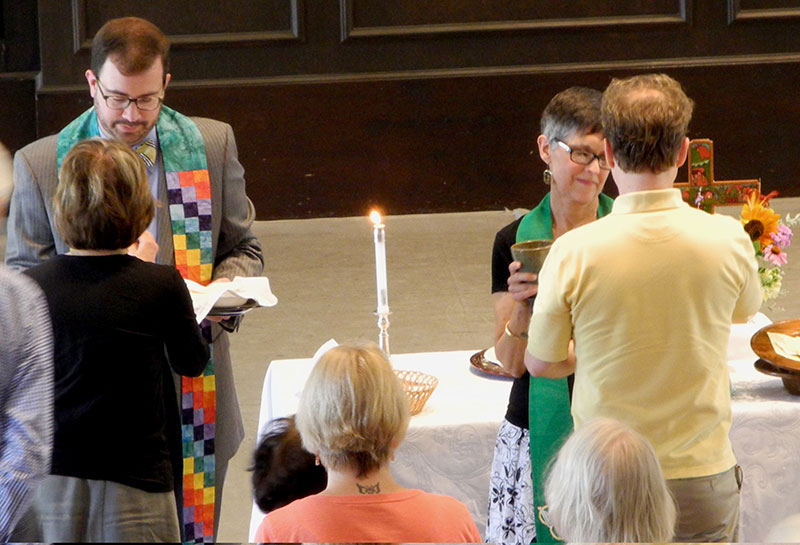OCBC’s Peace & Justice History
A pioneer among churches who are welcoming and affirming of gay and lesbian (currently GLBT) people, OCBC has supported gay rights openly since 1983. We helped co- found AWAB in 1983, but many people from OCBC were active well before that in the precursor organizations within TABCOM and ABC. This stance was a continuation of a longstanding social justice legacy, which included and still includes combating racism, protesting the Vietnam War, supporting the equality of women in the world and in worship services, giving energy to the Sanctuary Movement in the 1980s and immigrant rights today, and an active “green” conservation policy. Together, these legacies of resistance and activism function to give OCBC and its individual members an identity.
There are many references to this legacy in the paragraphs above on recent pastors, but a few more details are noted here. All of them continue to this day, but the dates below are when they were a primary focus.
1. CIVIL RIGHTS/BLACK LIBERATION
From 1963, to this day, OCBC has been active in racial justice. Ernie Klein went to the civil rights march in D.C., where parishioners Harvey Cox and Paul Chapman were sent to jail. And in 1968, the church gave $50,000, “no strings attached,” to the Community Development fund, which was to be used for “black self-determination.” Fifty years later, an active Racial Justice Group encourages increasing the church’s multicultural membership numbers and is networking with like-minded churches to support modern day “New Jim Crow” which work to erase prison inequity for people of color and protect minority voter registration in the face of a national backlash.
2. ANTI WAR and PEACE
In October 1969, OCBC offered sanctuary to Eric Mann, the leader of the Weatherman, who wished to explain his opposition to the Vietnam War before giving himself up to the police. In April of 1970, a violent antiwar riot in Harvard Square spilled over into the OCBC sanctuary, which served as a temporary first aid station and sanctuary. Members of the church participated in many marches against war and its human and financial waste, from Vietnam days to the current “operations” in Iraq and Afghanistan. We have been active in supporting Veterans for Peace.
3. FEMINISM
In the early 1970s, a group of women who called themselves Sojourners began to meet in the church’s tower room and claim political leadership within the church. The feminist movement was challenging ideas of male leadership and gender based assumptions, and this group focused on a radical re-imaging of faith, implementing gender equality in the church and the language of worship, and welcoming sexual minorities. The women’s and lesbian liberation movements overlapped in many ways, and more women in the church were coming out as lesbians. Not only was at least one woman, Betsy Sowers, inspired to enter the ministry at this time, several women ministers, settled, interim, and part time, have carried it on. The language of worship itself was transformed to make it more inclusive of a female and/or gender neutral deity.
4. SANCTUARY for CENTRAL AMERICAN REFUGEES
On December 4, 1984, OCBC became host to Estela Ramirez, an El Salvadoran trade unionist who was arrested and tortured on three separate occasions between 1981 and 1984 for her work. She took up residence in OCBC’s chapel for two weeks, where she was constantly surrounded by at least two “vigiling” members from OCBC who were trained in how to handle the very real threat of INS action. The congregation remains dedicated to today’s undocumented immigrants, who are often fleeing persecution by U.S.-backed dictatorships. Before and after this event, OCBC had supported and refugees, “undocumented” or not, including a pro-democracy family from Chile, who had to flee after the military coup there.
Just as Martin Luther King Jr. used Amos to critique the white establishment of his day, OCBC’s works are filed with references to scripture. Like many of the other churches in the Sanctuary Movement, they drew much of their strength from the biblical tradition of sanctuary, specifically referencing Deuteronomy 19:10: “And...let no innocent blood be shed in the land which the Lord your God is giving you, or else the responsibility for that blood will fall upon you.” This verse arises time and time again in OCBC’s conversations about their involvement with the Sanctuary Movement. Two other passages also occupy prominent places in OCBC’s conversations about Sanctuary, Matthew 22:37-40 and I John 4:18-21. According to OCBC’s statement of purpose, the congregation was acting “in the love that Jesus said sums up the Law and prophets. ‘Love the Lord your God with all your heart, with all your soul, and with all your mind. (And)...love your neighbor as yourself.’”
5. GAY AND LESBIAN and LGBT LIBERATION
OCBC’s theological interpretation of these same texts were crucial to its decision to become involved in the project of LGBT inclusion. The Daughters of Bilitis, an early and important lesbian group, rented office space in the church for years. The church’s involvement began in the 1980’s when the congregation’s pastor, Monica Styron, started a gay and lesbian support group. In 1983, according to Grace Peters, Monica approached Grace about producing a statement of “welcoming and affirming” congregation in 1983. Adopting this status in 1983, years before most of the progressive congregations in Harvard Square, meant that OCBC was placing itself in a vulnerable position, and the congregation’s further leadership within American Baptists Concerned meant that OCBC ran the very real risk of having its standing in the ABC (USA) revoked. While she was pastor, Monica came out as a lesbian. In 2013, AWAB (Association of Welcoming and Affirming Baptists) added its 88th member congregation. We continue to urge the American Baptist denomination to go on record as accepting LGBT people.
